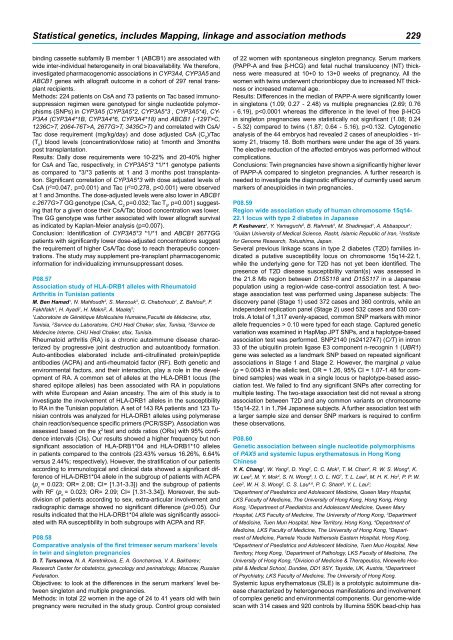2009 Vienna - European Society of Human Genetics
2009 Vienna - European Society of Human Genetics
2009 Vienna - European Society of Human Genetics
Create successful ePaper yourself
Turn your PDF publications into a flip-book with our unique Google optimized e-Paper software.
Statistical genetics, includes Mapping, linkage and association methods<br />
binding cassette subfamily B member 1 (ABCB1) are associated with<br />
wide inter-individual heterogeneity in oral bioavailability. We therefore,<br />
investigated pharmacogenomic associations in CYP3A4, CYP3A5 and<br />
ABCB1 genes with allograft outcome in a cohort <strong>of</strong> 297 renal transplant<br />
recipients.<br />
Methods: 224 patients on CsA and 73 patients on Tac based immunosuppression<br />
regimen were genotyped for single nucleotide polymorphisms<br />
(SNPs) in CYP3A5 (CYP3A5*2, CYP3A5*3 , CYP3A5*4), CY-<br />
P3A4 (CYP3A4*1B, CYP3A4*6, CYP3A4*18) and ABCB1 (-129T>C,<br />
1236C>T, 2064-76T>A, 2677G>T, 3435C>T) and correlated with CsA/<br />
Tac dose requirement (mg/kg/day) and dose adjusted CsA (C 2 )/Tac<br />
(T 0 ) blood levels (concentration/dose ratio) at 1month and 3months<br />
post transplantation.<br />
Results: Daily dose requirements were 10-22% and 20-40% higher<br />
for CsA and Tac, respectively, in CYP3A5*3 *1/*1 genotype patients<br />
as compared to *3/*3 patients at 1 and 3 months post transplantation.<br />
Significant correlation <strong>of</strong> CYP3A5*3 with dose adjusted levels <strong>of</strong><br />
CsA (r 2 =0.047, p=0.001) and Tac (r 2 =0.278, pT GG genotype (CsA, C 2 p=0.032; Tac T 0 , p=0.001) suggesting<br />
that for a given dose their CsA/Tac blood concentration was lower.<br />
The GG genotype was further associated with lower allograft survival<br />
as indicated by Kaplan-Meier analysis (p=0.007).<br />
Conclusion: Identification <strong>of</strong> CYP3A5*3 *1/*1 and ABCB1 2677GG<br />
patients with significantly lower dose-adjusted concentrations suggest<br />
the requirement <strong>of</strong> higher CsA/Tac dose to reach therapeutic concentrations.<br />
The study may supplement pre-transplant pharmacogenomic<br />
information for individualizing immunsuppressant doses.<br />
P08.57<br />
Association study <strong>of</strong> HLA-DRB1 alleles with Rheumatoid<br />
Arthritis in tunisian patients<br />
M. Ben Hamad 1 , N. Mahfoudh 2 , S. Marzouk 3 , G. Chabchoub 1 , Z. Bahloul 3 , F.<br />
Fakhfakh 1 , H. Ayadi 1 , H. Makni 2 , A. Maalej 1 ;<br />
1 Laboratoire de Génétique Moléculaire Humaine,Faculté de Médecine, sfax,<br />
Tunisia, 2 Service du Laboratoire, CHU Hedi Chaker, sfax, Tunisia, 3 Service de<br />
Médecine Interne, CHU Hedi Chaker, sfax, Tunisia.<br />
Rheumatoid arthritis (RA) is a chronic autoimmune disease characterized<br />
by progressive joint destruction and autoantibody formation.<br />
Auto-antibodies elaborated include anti-citrullinated protein/peptide<br />
antibodies (ACPA) and anti-rheumatoid factor (RF). Both genetic and<br />
environmental factors, and their interaction, play a role in the development<br />
<strong>of</strong> RA. A common set <strong>of</strong> alleles at the HLA-DRB1 locus (the<br />
shared epitope alleles) has been associated with RA in populations<br />
with white <strong>European</strong> and Asian ancestry. The aim <strong>of</strong> this study is to<br />
investigate the involvement <strong>of</strong> HLA-DRB1 alleles in the susceptibility<br />
to RA in the Tunisian population. A set <strong>of</strong> 143 RA patients and 123 Tunisian<br />
controls was analyzed for HLA-DRB1 alleles using polymerase<br />
chain reaction/sequence specific primers (PCR/SSP). Association was<br />
assessed based on the χ 2 test and odds ratios (ORs) with 95% confidence<br />
intervals (CIs). Our results showed a higher frequency but non<br />
significant association <strong>of</strong> HLA-DRB1*04 and HLA-DRB1*10 alleles<br />
in patients compared to the controls (23.43% versus 16.26%, 6.64%<br />
versus 2.44%; respectively). However, the stratification <strong>of</strong> our patients<br />
according to immunological and clinical data showed a significant difference<br />
<strong>of</strong> HLA-DRB1*04 allele in the subgroup <strong>of</strong> patients with ACPA<br />
(p c = 0.023; OR= 2.08; CI= [1.31-3.3]) and the subgroup <strong>of</strong> patients<br />
with RF (p c = 0.023; OR= 2.09; CI= [1.31-3.34]). Moreover, the subdivision<br />
<strong>of</strong> patients according to sex, extra-articular involvement and<br />
radiographic damage showed no significant difference (p>0.05). Our<br />
results indicated that the HLA-DRB1*04 allele was significantly associated<br />
with RA susceptibility in both subgroups with ACPA and RF.<br />
P08.58<br />
Comparative analysis <strong>of</strong> the first trimeser serum markers’ levels<br />
in twin and singleton pregnancies<br />
D. T. Tursunova, N. A. Karetnikova, E. A. Goncharova, V. A. Bakharev;<br />
Research Center for obstetrics, gynecology and perinatology, Moscow, Russian<br />
Federation.<br />
Objectives: to look at the differences in the serum markers’ level between<br />
singleton and multiple pregnancies.<br />
Methods: in total 22 women in the age <strong>of</strong> 24 to 41 years old with twin<br />
pregnancy were recruited in the study group. Control group consisted<br />
<strong>of</strong> 22 women with spontaneous singleton pregnancy. Serum markers<br />
(PAPP-A and free β-HCG) and fetal nuchal translucency (NT) thickness<br />
were measured at 10+0 to 13+0 weeks <strong>of</strong> pregnancy. All the<br />
women with twins underwent chorionbiopsy due to increased NT thickness<br />
or increased maternal age.<br />
Results: Differences in the median <strong>of</strong> PAPP-A were significantly lower<br />
in singletons (1.09; 0.27 - 2.48) vs multiple pregnancies (2.69; 0.76<br />
- 6.19), p

















